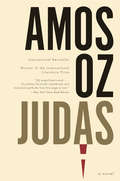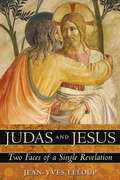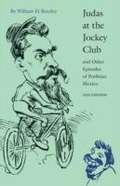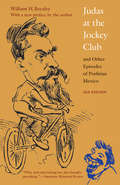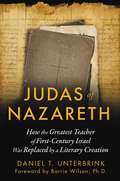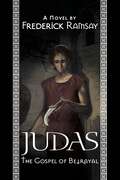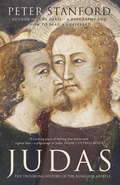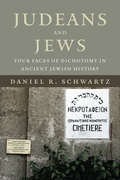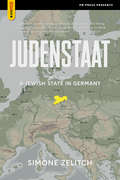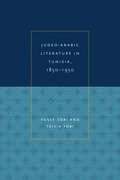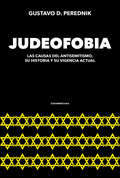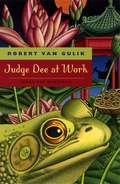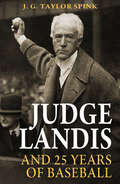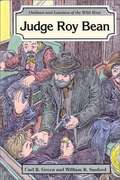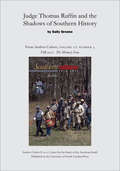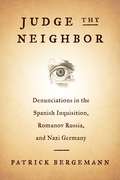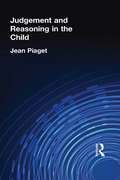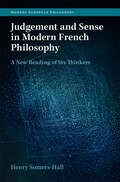- Table View
- List View
Judas
by Amos OzInternational Bestseller Winner of the International Literature Prize Finalist for the Man Booker International Prize A New York Times Editors’ Choice “[A] magnificent novel . . . Oz pitches the book’s heartbreak and humanism perfectly from first page to last.” — New York Times Book Review “Scintillating . . . An old-fashioned novel of ideas that is strikingly and compellingly modern.” — Observer Jerusalem, 1959. Shmuel Ash, a biblical scholar, is adrift in his young life when he finds work as a caregiver for a brilliant but cantankerous old man named Gershom Wald. There is, however, a third, mysterious presence in his new home. Atalia Abravanel, the daughter of a deceased Zionist leader, a beautiful woman in her forties, entrances young Shmuel even as she keeps him at a distance. Piece by piece, the old Jerusalem stone house, haunted by tragic history and now home to the three misfits and their intricate relationship, reveals its secrets. At once an exquisite love story and a coming-of-age novel, an allegory for the state of Israel and for the biblical tale from which it draws its title, Judas is Amos Oz’s most powerful novel in decades. “Oz has written one of the most triumphant novels of his career.” — Forward “A [big] beautiful novel . . . Funny, wise, and provoking.” — Times (UK)
Judas
by Marvin MeyerJudas Iscariot has been demonized as the quintessential traitor, the disciple who betrayed his master for the infamous thirty pieces of silver. But the recent sensational discovery and publication of the long lost Gospel of Judas, with its remarkable portrayal of Judas Iscariot as the disciple closest to Jesus, raises serious new questions. Was Judas the only member of the Twelve who truly understood Jesus? Did Jesus secretly collaborate with Judas to set in motion the series of events that would redeem all of humankind? In search of answers, Marvin Meyer, one of the world's leading experts on the Gospel of Judas presents a collection of the earliest accounts of Judas, which together paint a fuller portrait of this most enigmatic disciple. This book presents the essential texts that deal with the figure of Judas, including New Testament writings, Gnostic documents, and other early and later Christian literature. These are the earliest known testimonies about Judas and include selections from the gospels of Mark, Matthew, Luke, and John, the Acts of the Apostles, and relevant passages from Paul. The centerpiece of the book is the Gospel of Judas, followed by excerpts from three other Gnostic texts--the Dialogue of the Savior, the Concept of Our Great Power, and the "Round Dance of the Cross"--which may shed new light on the figure of Judas. A series of additional writings on Judas produced over the centuries provide glimpses of the vilification of Judas and the emergence of anti-Semitic themes. Meyer offers evidence of traitors before Judas--the Genesis story of Joseph's brothers who sold him into slavery, the duplicitous friend of the poet in Psalm 41, and Melanthius the goatherd in Homer's Odyssey--all of which raise the question of whether the story of Judas Iscariot could be simply a piece of religious fiction derived from earlier stories. Judas provides a rich collection of original sources that tell the story of Christianity's most infamous figure, offering the fullest understanding of Judas Iscariot's undeniable importance in the climax of Jesus's life.
Judas
by Marvin W. MeyerJudas Iscariot has been demonized as the quintessential traitor, the disciple who betrayed his master for the infamous thirty pieces of silver. But the recent sensational discovery and publication of the long lost Gospel of Judas, with its remarkable portrayal of Judas Iscariot as the disciple closest to Jesus, raises serious new questions. Was Judas the only member of the Twelve who truly understood Jesus? Did Jesus secretly collaborate with Judas to set in motion the series of events that would redeem all of humankind? In search of answers, Marvin Meyer, one of the world's leading experts on the Gospel of Judas presents a collection of the earliest accounts of Judas, which together paint a fuller portrait of this most enigmatic disciple.This book presents the essential texts that deal with the figure of Judas, including New Testament writings, Gnostic documents, and other early and later Christian literature. These are the earliest known testimonies about Judas and include selections from the gospels of Mark, Matthew, Luke, and John, the Acts of the Apostles, and relevant passages from Paul. The centerpiece of the book is the Gospel of Judas, followed by excerpts from three other Gnostic texts--the Dialogue of the Savior, the Concept of Our Great Power, and the "Round Dance of the Cross"--which may shed new light on the figure of Judas. A series of additional writings on Judas produced over the centuries provide glimpses of the vilification of Judas and the emergence of anti-Semitic themes.Meyer offers evidence of traitors before Judas--the Genesis story of Joseph's brothers who sold him into slavery, the duplicitous friend of the poet in Psalm 41, and Melanthius the goatherd in Homer's Odyssey--all of which raise the question of whether the story of Judas Iscariot could be simply a piece of religious fiction derived from earlier stories. Judas provides a rich collection of original sources that tell the story of Christianity's most infamous figure, offering the fullest understanding of Judas Iscariot's undeniable importance in the climax of Jesus's life.
Judas Flowering
by Jane Aiken HodgeSet against the background of war-torn Savannah during the Revolution, this enchanting novel unfolds the saga of a family divided-and a beautiful heroine. Mercy Phillips, caught desperately between the passions of Rebel and a Tory. Mercy Phillips was a penniless English orphan when Hart Purchis, wealthy young heir to the Winchelsea Plantation, rescued her from the mob. Hart did not know it then, but Mercy was to play a part in his life that would shape not only the future of Winchelsea, but the whole American Revolution itself.
Judas and Jesus: Two Faces of a Single Revelation
by Jean-Yves LeloupA radical reinterpretation of the relationship of Judas and Jesus • Reexamines the role and the purpose the key figure of Judas played in the crucifixion story • Reveals how Judas was “betrayed” by Jesus, and how, taken to the limits of his humanity, he lost everything he most cherished on the path to his true self The familiar story of Judas, betrayer of Jesus, is striking because of its incomprehensibility. Why would one of Christ’s disciples and companions of the heart deliver him up to his enemies and a barbarous, ignominious, and certain death for thirty pieces of silver? Jean-Yves Leloup’s careful investigation of the gospels, various apocryphal texts, and most importantly the Coptic codex known as the Gospel of Judas, leads him to conclude that there is more to the familiar story of Judas than a simple demonstration, viewed through one man, of humanity’s inherent failings. The betrayal of Jesus to the Romans was Jesus’s idea, explains Leloup. Jesus persuaded Judas to play the role of “evil” in humankind by telling him that this enactment was crucial to God’s plan and would set Judas by Jesus’s side for eternity: “There where I am,” spoke Jesus to Judas, “is where I wish you, too, to be.” But to get there, Judas--a metaphorical representation of the darker side present in all human beings and the “shadow” counterpart to his Messiah dying on the cross-- must first shed all his human qualities. His failings of greed, deceit, and cowardice--and even his faith and hope--are washed away in the despair that engulfs him. A parallel moment occurs for Jesus on the cross, when he comes to know the despair of separation from God. The moment Judas “loses” his life and all that gave it meaning--his God, his law, his justice, his Messiah--is the very moment he finds that which cannot be discarded--life eternal. Thus, in the moment of his ultimate extremity, Judas receives Jesus’s true message and his intended gift.
Judas at the Jockey Club and Other Episodes of Porfirian Mexico, Second Edition
by William H. BeezleyThis brilliant and eminently readable cultural history looks at Mexican life during the dictatorship of Porfirio Díaz, from 1876 to 1911. At that time Mexico underwent modernization, which produced a fierce struggle between the traditional and the new and exacerbating class antagonisms. In these pages, the noted historian William H. Beezley illuminates many facets of everyday Mexican life lying at the heart of this conflict and change, including sports, storytelling, healthcare, technology, and the traditional Easter-time Judas burnings that became a primary focus of the strife during those years. This second edition features a new preface by the author as well as updated and expanded text, notes, and bibliography.
Judas at the Jockey Club and Other Episodes of Porfirian Mexico, Third Edition
by William H. BeezleyFeaturing a new preface by the author, this brilliant and eminently readable cultural history looks at Mexican life during the dictatorship of Porfirio Díaz, from 1876 to 1911. At that time the modernization that Mexico underwent produced a fierce struggle between the traditional and the new, exacerbating class antagonisms in the process. The noted historian William H. Beezley illuminates many facets of everyday Mexican life lying at the heart of this conflict and change, including sports, storytelling, health care, technology, and the traditional Easter‑time Judas burnings that became a primary focus of strife during those years. This updated volume provides a teacher’s guide, available on the University of Nebraska Press website, offering a manual of internet links, additional readings, and practice experiences that can be used in the classroom or by anyone who wants to go beyond the chapters of this book.
Judas of Nazareth: How the Greatest Teacher of First-Century Israel Was Replaced by a Literary Creation
by Barrie Wilson Daniel T. UnterbrinkAn investigation into the historical Jesus and the veracity of the Gospels • Reveals the biblical Jesus as a composite figure, a blend of the political revolutionary Judas the Galilean and Paul’s divine-human Christ figure • Matches the events depicted in the New Testament with historically verifiable events in Josephus’ history, pushing Jesus’ life back more than a decade • Demonstrates how each New Testament Gospel is dependent upon Paul’s mythologized Christ theology, designed to promote Paul’s Christianity and serve the interests of the fledgling Gentile Christian communities Scholars have spent years questioning aspects of the historical Jesus. How can we know what Jesus said and did when Jesus himself wrote nothing? Can we trust the Gospels, written by unknown authors 40 to 70 years after Jesus’ death? And why do other sources from the time not speak of this messianic figure known as Christ? Drawing on the histories of Josephus, Tacitus, Suetonius, and Pliny as well as the Dead Sea Scrolls, Daniel Unterbrink contends that the “Jesus” of the Bible was actually a composite figure, a clever blend of the Jewish freedom-fighter Judas the Galilean and Paul’s divine-human Christ figure created in the middle of the first century CE. Revealing why Paul was known as a liar, enemy, and traitor in other Jewish literature, he shows that the New Testament Gospels are not transcripts of actual history but creative works of historical fiction designed to promote Paul’s Christianity and serve the interests of the fledgling Gentile Christian communities. He demonstrates how each Gospel is written in light of the success of Paul’s religion and dependent upon his later perspective. Matching the events depicted in the New Testament with the historically verifiable events in Josephus’ history, Unterbrink pushes the dating of Jesus’ life back nearly a generation to a revolutionary time in ancient Judea. He shows that the real historical Jesus--the physical man behind the fictional stories in Paul’s Gospels--was Judas the Galilean: a messianic pretender and Torah-observant revolutionary bent on overthrowing the Roman government and galvanizing the Jewish people behind his vision of the coming Kingdom of God. In the greatest cover-up of history, this teacher of first-century Israel was replaced by the literary creation known as Jesus of Nazareth.
Judas: The Gospel of Betrayal (Jerusalem Mysteries)
by Frederick RamsayThe child Judas, illegitimate offspring of a Jewish woman and a Roman soldier, struggles to understand his mother's god, a god who allows terrible things to happen to him and his family. Despairing, he becomes a survivor in the brutal streets of the first century Roman Empire.Later, as a young man determined to avenge the wrongs committed against his family, he joins the rebels led by Barabbas, only to be betrayed by them as well. Beaten and broken, he is brought to the community of Zealots at Qumran and eventually to the one forming around Rabbi Jesus. But his enthusiasm for revolution leads him to make a difficult and—for him and others—fateful choice.
Judas: The troubling history of the renegade apostle
by Peter StanfordIn this fascinating historical and cultural biography, writer and broadcaster Peter Stanford deconstructs that most vilified of Bible characters: Judas Iscariot, who famously betrayed Jesus with a kiss. Beginning with the gospel accounts, Peter explores two thousand years of cultural and theological history to investigate how the very name Judas came to be synonymous with betrayal and, ultimately, human evil. But as Peter points out, there has long been a counter-current of thought that suggests that Judas might in fact have been victim of a terrible injustice: central to Jesus' mission was his death and resurrection, and for there to have been a death, there had to be a betrayal. This thankless role fell to Judas; should we in fact be grateful to him for his role in the divine drama of salvation? 'You'll have to decide,' as Bob Dylan sang in the sixties, 'Whether Judas Iscariot had God on his side'.An essential but doomed character in the Passion narrative, and thus the entire story of Christianity, Judas and the betrayal he symbolises continue to play out in much larger cultural histories, speaking as he does to our deepest fears about friendship, betrayal and the problem of evil. Judas: the ultimate traitor, or the ultimate scapegoat? This is a compelling portrait of Christianity's most troubling and mysterious character.
Judas: The troubling history of the renegade apostle
by Peter StanfordIn this fascinating historical and cultural biography, writer and broadcaster Peter Stanford deconstructs that most vilified of Bible characters: Judas Iscariot, who famously betrayed Jesus with a kiss. Beginning with the gospel accounts, Peter explores two thousand years of cultural and theological history to investigate how the very name Judas came to be synonymous with betrayal and, ultimately, human evil. But as Peter points out, there has long been a counter-current of thought that suggests that Judas might in fact have been victim of a terrible injustice: central to Jesus' mission was his death and resurrection, and for there to have been a death, there had to be a betrayal. This thankless role fell to Judas; should we in fact be grateful to him for his role in the divine drama of salvation? 'You'll have to decide,' as Bob Dylan sang in the sixties, 'Whether Judas Iscariot had God on his side'.An essential but doomed character in the Passion narrative, and thus the entire story of Christianity, Judas and the betrayal he symbolises continue to play out in much larger cultural histories, speaking as he does to our deepest fears about friendship, betrayal and the problem of evil. Judas: the ultimate traitor, or the ultimate scapegoat? This is a compelling portrait of Christianity's most troubling and mysterious character.
Jude Deveraux Collectors' Edition Box Set
by Jude DeverauxRediscover all of the magic and romance of Edilean in this special collector's edition box set of Jude Deveraux's New York Times bestsellers: Lavender Morning, Days of Gold, and Scarlet Nights. Plus, get a special early look at Heartwishes, the latest in Jude Deveraux's Edilean series!Lavender MorningJocelyn Minton is a woman torn between two worlds. Her mother grew up attending private schools and afternoon teas, but she married the local handyman. After her mother died when Joce was only five years old, her father remarried into his own class, and Joce became an outsider -- until she met Edilean Harcourt. Although she was sixty years Joce's senior, Miss Edi was a kindred soul who understood her like no one else ever had. When Miss Edi passes away, she leaves Joce all her worldly possessions, including an eighteenth-century house and a letter with clues to a mystery that began in 1941. In the letter, Miss Edi also mentions that she has found the perfect man for Joce -- a handsome young lawyer. Joce is shocked to learn that the mystery, the house, and the future love of her life are all in Edilean, a small town in Virginia that Miss Edi never told her about. Hurt that the woman who meant so much to her kept so many secrets, Jocelyn moves to this tight-knit village in an attempt to understand the legacy that has been left to her. As she begins to dig into Miss Edi's mystery, she soon discovers some shocking surprises about her family's history and her own future -- and she meets a man with his own mysterious past. Days of GoldIn 1766 Scotland, the laird of the clan, Angus McTern, has everything he wants in life. Although his grandfather lost the family's land and castle in a card game when Angus was just a boy, Angus takes his duties seriously and is respected by all the men and adored by the women. That is, until Edilean Talbot shows up. Breathtakingly beautiful and born of privilege, Edilean represents everything Angus despises. Still he is as dazzled by her as everyone else is, and he can keep his feelings hidden from her for only so long. When she rejects him he is deeply wounded and, worse, humiliated before his clan. But then the day comes when Edilean needs Angus's help, to reclaim the gold she inherited from her father, which is on its way to America. At first Angus refuses, but her beauty -- and her tears -- so haunt him that he puts aside his pride and decides to aid the heiress. However, when Angus tries to intervene, he's accused of kidnapping and theft. To avoid being prosecuted, he's forced to leave behind all that he knows and loves and escape with Edilean to America. There they will overcome almost insurmountable obstacles as they are pursued endlessly by the man who claims the gold for his own. Despite all that tries to keep them apart, Angus and Edilean also find a love as wild and free as the land itself. Scarlet NightsSara Shaw and Greg Anders are engaged to be married. Unfortunately, unknown to Sara, Greg is a big time fraud man, descended from a long line of con artists and thieves. In fact, his mother is also in Edilean, incognito, and master minding a scheme to pull off the heist of a lifetime -- and Greg is using Sara to get closer to what his mother is seeking.But when Mike Newland, an undercover cop who is investigating Greg and his family, enters the picture, he is able to tip Sara off that her fiancÉe is not who he seems - and he asks her help in catching the criminals the Feds have been trying to capture for over 20 years. Instead of planning her wedding, Sara becomes involved in Mike's plan to get evidence against Greg and his mother, and that involves using Sara as bait. Terrified, Sara must pretend that she still loves Greg even after she finds out the truth about him. And along the way, Sara gets to know Mike and finds out about his long connection to the town of Edilean. Together, with the help of Jocelyn from Lavender Morning, they at last learn the secret that has been haunting the town of Edilean for almost 70 years. As in Lavender Morning, the story is told with historical flashba...
Jude the Obscure
by Thomas HardyHardy called this story 'a deadly war waged between flesh and spirit'. It is a tale of doomed love and unfulfilled promise that revolves around Jude Fawley, an ambitious and intelligent young man, his cousin Sue Bridehead and his academic mentor Phillotson.(P)1996 Hodder & Stoughton Audiobooks
Judeans and Jews
by Daniel R. SchwartzIn writing in English about the classical era, is it more appropriate to refer to "Jews" or to "Judeans"? What difference does it make? Today, many scholars consider "Judeans" the more authentic term, and "Jews" and "Judaism" merely anachronisms.In Judeans and Jews, Daniel R. Schwartz argues that we need both terms in order to reflect the dichotomy between the tendencies of those, whether in Judea or in the Disapora, whose identity was based on the state and the land (Judeans), and those whose identity was based on a religion and culture (Jews).Presenting the Second Temple era as an age of transition between a territorial past and an exilic and religious future, Judeans and Jews not only sharpens our understanding of this important era but also sheds important light on the revolution in Jewish identity caused by the creation of the modern state of Israel.
Judenstaat: The Novel Of A Jewish State In Germany (Spectacular Fiction)
by Simone ZelitchIt is 1988. Judit Klemmer is a filmmaker who is assembling a fortieth-anniversary official documentary about the birth of Judenstaat, the Jewish homeland surrendered by defeated Germany in 1948. Her work is complicated by Cold War tensions between the competing U.S. and Soviet empires and by internal conflicts among the "black-hat" Orthodox Jews, the far more worldly Bundists, and reactionary Saxon nationalists, who are still bent on destroying the new Jewish state. But Judit's work has far more personal complications. A widow, she has yet to deal with her own heart's terrible loss—the very public assassination of her husband, Hans Klemmer, shot dead while conducting a concert. Then a shadowy figure slips her a note, with new and potentially dangerous information about her famous husband's murder. Then the ghost steps in...
Judeo-Arabic Literature in Tunisia, 1850-1950
by Tsivia Tobi Yosef TobiAs a result of the introduction of the printing press in the mid-nineteenth century and the proximity of European culture, language, and literature after the French occupation in 1881, Judeo-Arabic literature flourished in Tunisia until the middle of the twentieth century. As the most spoken language in the country, vernacular Judeo-Arabic allowed ideas from the Jewish Enlightenment in Europe (the Haskalah) to spread widely and also offered legitimacy to the surrounding Arab culture. In this volume, authors Yosef and Tsivia Tobi present works of Judeo-Arabic Tunisian literature that have been previously unstudied and unavailable in translation. In nine chapters, the authors present a number of works that were both originals and translations, divided by genre. Beginning each with a brief introduction to the material, they present translations of piyyutim (liturgical poems), malzumat (satirical ballads), qinot (laments), ghnayat (songs), essays on ideology and propaganda, drama and the theater, hikayat and deeds of righteous men (fiction), and Daniel Hagège's Circulation of Tunisian Judeo-Arabic Books, an important early critical work. A comprehensive introduction details the flowering of Judeo-Arabic literature in North Africa and appendixes of Judeo-Arabic journals, other periodicals, and books complete this volume. Ultimately, the authors reveal the effect of Judeo-Arabic literature on the spiritual formation of not only the literate male population of Tunisian Jews, who spent a good part of their time at the synagogue, but also on women, the lower and middle classes, and conservatives who leaned toward modernization. Originally published in Hebrew, Judeo-Arabic Literature in Tunisia, 1850-1950 will be welcomed by English-speaking scholars interested in the literature and culture of this period.
Judeofobia: Las causas del antisemitismo, su historia y su vigencia actual
by Gustavo Perednik¿Cuáles son los orígenes del odio antijudío? ¿Cuáles fueron sus motivaciones históricas y cuáles sus mitos fundantes? ¿Cuáles las causas de su persistencia? El odio a los judíos, la judeofobia, es uno de los más antiguos y persistentes de la historia. Desde los escritos de Alejandría y la expulsión de España hasta el cantonismo ruso y el Holocausto, es un fenómeno que ha atravesado todas las épocas y se manifiesta de formas diferentes, ora sutiles, ora brutales, todavía en nuestros días. Tanto los medios y la esfera pública como los ámbitos más privados y cotidianos son arena en la que a cada momento se despliega una miríada de prejuicios. ¿Cuáles son las peculiaridades de la judeofobia que hacen que emerja una y otra vez, incluso en los rincones menos esperados? En este libro indispensable, Gustavo Perednik responde esta y otras preguntas al tiempo que explora a fondo los orígenes, las motivaciones y los mitos fundantes de la hostilidad antijudía. Porque contra todo pronóstico optimista, nuestro siglo XXI sigue demandando una mirada alerta que oponga racionalidad reflexiva a la sinrazón demonizadora.
Judeophobia and the New Testament: Texts and Contexts
by Eric M. Vanden Eykel and Meredith J. C. WarrenAn essential resource for understanding the troubling role of the Christian scriptures in anti-Semitism This eye-opening collection of essays is essential reading for anyone concerned about the ways that Christian scripture has been used—both in the past and the present—in service of anti-Semitism. The authors seek to identify, contextualize, and problematize New Testament &“Judeophobia,&” a broad heading that encompasses anti-Semitism, supersessionism, and various discriminatory practices against Jews at different points in history. In the first half of Judeophobia and the New Testament: Texts and Contexts, readers engage with the subject matter through thematic essays. In the second half, readers engage with text-based essays that focus on individual books of the New Testament as well as relevant non-canonical literature. Throughout, the book&’s goal is to educate readers about the ways that New Testament texts have been used to engender Judeophobia from the early church to today. While the book is designed primarily as a resource for teachers and students, it also aims to help New Testament scholars account for Judeophobic interpretations, take responsibility for them, and encourage the discipline to work against its own role in rising anti-Jewish rhetoric and violence.Contributors Matthew R. Anderson Jeremiah Bailey Mary Ann Beavis Chance E. Bonar Tom de Bruin Christy Cobb Cavan Concannon David L. Eastman Scott S. Elliott Sarah Emanuel Emily Gathergood Mark Godin Jill Hicks-Keeton Meira Z. Kensky Kyu Seop Kim Brian Yong Lee Harry O. Maier Shelly Matthews James F. McGrath Hugo Méndez Mark D. Nanos Sara Parks Shaily Shashikant Patel Adele Reinhartz Michael Scott Robertson Sarah E. Rollens Justin Jeffcoat Schedtler Nathan Shedd Shayna Sheinfeld Ekaputra Tupamahu Eric Vanden Eykel Alana M. Vincent Meredith J. C. Warren Taylor M. Weaver
Judge Dee at Work: Eight Chinese Detective Stories
by Robert H. Van GulikThese eight stories, featuring the master-detective of Ancient China and his assistants Ma Joong, Sergeant Hoong, and Chiao Tai, cover a decade during which the judge served in four different provinces of the T'ang Empire. From the suspected treason of a general in the Chinese army facing the Tartar hordes on the western frontier to the murder of a lonely poet in his garden pavilion in Han-yuan, the cases presented here are among the most memorable of Judge Dee's long and distinguished career.
Judge Landis and 25 Years of Baseball
by J. G. Taylor SpinkJudge Landis and 25 Years of Baseball, first published in 1947, is a look at the career of Judge Kenesaw Mountain Landis, a federal judge and professional baseball’s first commissioner, who served in that position for 25 years until his death in 1944. The book, authored by J. G. Taylor Spink, editor of the influential The Sporting News, also serves as a history of major league baseball at that time - the team owners, the players, the legal battles, and the scandals (including the infamous “Black Sox” scandal). Judge Landis’s decisive actions and iron rule over the game were largely responsible for restoring public confidence in the sport. Included are 5 pages of photographs.
Judge Roy Bean (Outlaws and Lawmen of the Wild West)
by Carl R. Green William R. Sanford- Biographies of famous and infamous men of the Western frontier. - Entices the reluctant reader to relive the exciting days of the Wild West.
Judge Thomas Ruffin and the Shadows of Southern History
by Sally GreeneJudge Thomas Ruffin and the Shadows of Southern Historyby Sally GreeneNorth Carolina's State Capitol still houses a statue to one of southern history's most notorious pro-slave-owner judges. Why?"Ruffin was ideologically sympathetic to the Confederate cause and remained so to his death. 'The power of the master must be absolute,' Ruffin wrote in State v. Mann (1829), 'to render the submission of the slave perfect.' State v. Mann became the most notorious opinion in the entire body of slavery law."
Judge Thy Neighbor: Denunciations in the Spanish Inquisition, Romanov Russia, and Nazi Germany (The Middle Range Series)
by Patrick BergemannFrom the Spanish Inquisition to Nazi Germany to the United States today, ordinary people have often chosen to turn in their neighbors to the authorities. What motivates citizens to inform on the people next door? In Judge Thy Neighbor, Patrick Bergemann provides a theoretical framework for understanding the motives for denunciations in terms of institutional structures and incentives.In case studies of societies in which denunciations were widespread, Bergemann merges historical and quantitative analysis to explore individual reasons for participation. He sheds light on Jewish converts’ shifting motives during the Spanish Inquisition; when and why seventeenth-century Romanov subjects fulfilled their obligation to report insults to the tsar’s honor; and the widespread petty and false complaints filed by German citizens under the Third Reich, as well as present-day plea bargains, whistleblowing, and crime reporting. Bergemann finds that when authorities use coercion or positive incentives to elicit information, individuals denounce out of self-preservation or to gain rewards. However, in the absence of these incentives, denunciations are often motivated by personal resentments and grudges. In both cases, denunciations facilitate social control not because of citizen loyalty or moral outrage but through the local interests of ordinary participants. Offering an empirically and theoretically rich account of the dynamics of denunciation as well as vivid descriptions of the denounced, Judge Thy Neighbor is a timely and compelling analysis of the reasons people turn in their acquaintances, with relevance beyond conventionally repressive regimes.
Judgement and Reasoning in the Child
by Jean PiagetOver a period of six decades, Jean Piaget conducted a program of naturalistic research that has profoundly affected our understanding of child development.
Judgement and Sense in Modern French Philosophy: A New Reading of Six Thinkers (Modern European Philosophy)
by Henry Somers-HallThis book proposes a radical new reading of the development of twentieth-century French philosophy. Henry Somers-Hall argues that the central unifying aspect of works by philosophers including Sartre, Foucault, Merleau-Ponty, Deleuze and Derrida is their attempt to provide an account of cognition that does not reduce thinking to judgement. Somers-Hall shows that each of these philosophers is in dialogue with the others in a shared project (however differently executed) to overcome their inheritances from the Kantian and post-Kantian traditions. His analysis points up the continuing relevance of German idealism, and Kant in particular, to modern French philosophy, with novel readings of many aspects of the philosophies under consideration that show their deep debts to Kantian thought. The result is an important account of the emergence, and essential coherence, of the modern French philosophical tradition.
